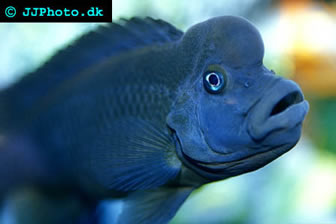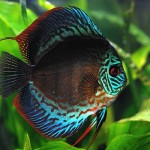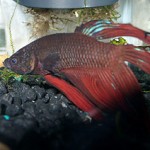Common name: Lionhead cichlid, blockhead cichlid
Scientif name: Steatocranus casuarius
Max size: Males 4 ½ in / 11 cm, females 2 in / 8 cm
pH: 6.0 – 8.0
Temperature: 73 – 82 ° F / 23 – 28 ° C
The Lionhead cichlid is different from most other cichlids since it rarely ever swims; it just jumps over the bottom of the tank. This behaviour is an adaptation to the environment it inhabits in the wild. Lionhead cichlids live in rapidly moving creeks and rivers. By skipping along the bottom they need to spend less energy fighting the current. The Lionhead cichlid is native to eastern Africa where it is found in the Congo – Zaire region.
The Lionhead cichlid has a reduced swim bladder which makes it much less buoyant than other cichlids. This means that it can not swim as gracefully as other cichlids even if it wanted to. This too is an adaptation to environment it lives in.
The Lionhead cichlid is a hardy species that can be recommended as someone’s first cichlid.
Aquarium setup
The Lionhead cichlid can be kept in a aquarium that is at least 30 gallon (150L) or bigger. The aquarium should be setup to mimic the natural habitat of this cichlid. This means relatively strong current and a lot f open areas as well as rocks and caves. Try to create some areas that are less affected by the current. Plants are not necessary and if you want to use plants you should only use hardy species. Lionhead cichlids will usually leave plants alone, but there is always a risk. Strong current is not a necessity when you keep this species but you should keep he water clean and well oxygenated.
The lion head cichlid is not very demanding in regards to water conditions but it prefers neutral water (tolerates pH 6.0 – 8.0) and a temperature between 73 and 82 ° F /23 and 28 ° C. Changing 30-50% of the water weekly is recommended.
Lionhead cichlids are best kept in pairs. This species form very strong pairs and it can be hard to get a Lionhead cichlid to accept a new partner if the old one dies. They are very aggressive towards other specimens of their own species (outside the pair). This species can be kept with other cichlids with similar needs and goes very well with Central American cichlids.
Feeding Lionhead cichlids
Lionhead cichlids accept most food types and willingly will eat cichlids pellets and other dry food. They should be fed a varied diet consisting of both vegetable and animal food items. Feed young specimens 2-3 times a day, adults 1-2. Adults do well with a day or two without food every now and then. A good diet can consist of giving them cichlid pellets two times a day and various frozen foods once a day.
Sexing Lionhead cichlids
The males are larger and have a hump on the head. Females are smaller and without the hump. It can be hard to sex young cichlids. Lionhead cichlids can (just like all other cichlids) be sexed by looking at their genitals. Female genitals are rounder and broader. Male genitals are smaller and pointier.
Breeding Lionhead cichlids
This species is relatively easy to breed once you got a suitable pair. The best way to get good pairs is to let a group of juveniles grow up together and form their own pairs. Excess fish can then be removed from the aquarium and sold. Lionhead cichlids are usually very good parents. They prefer to spawn in a cave but can sometimes spawn on other surfaces. Provide the fish wit a lot of suitable caves. If they don’t find one to their liking, they might excavate one from under a rock. Each spawning usually result in just a small number of eggs. Large females can produce 150 eggs per spawning but batches as small as 20 eggs are commonplace. The eggs are adhesive and will stay attached to the roof of the cave. The eggs usually take about one week to hatch and it takes another week before the fry is free swimming. The fry can be fed newly hatched brine shrimp from day one. Lionhead cichlid fry are hardy just like their parents.

















I would like to buy same. please advise price of baby fish.